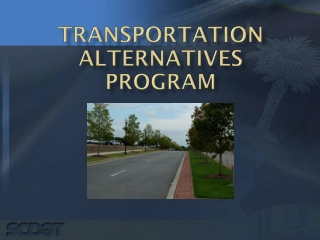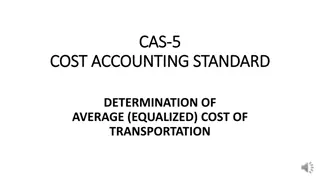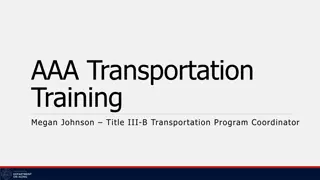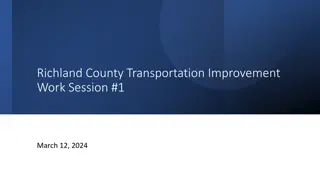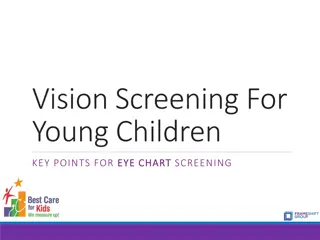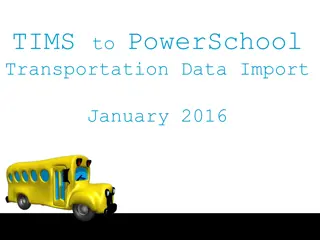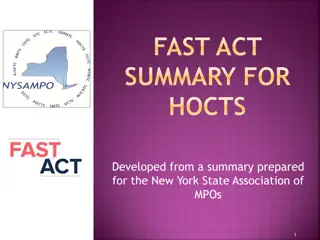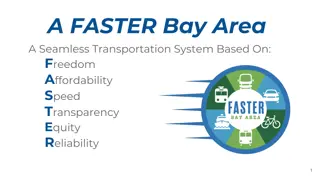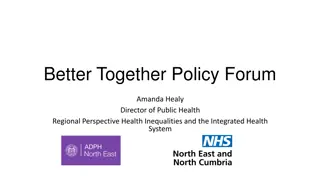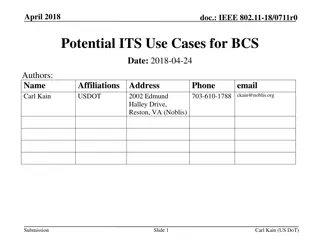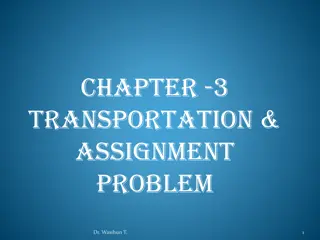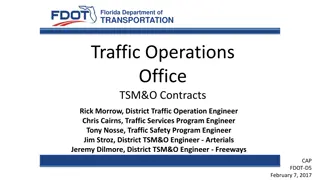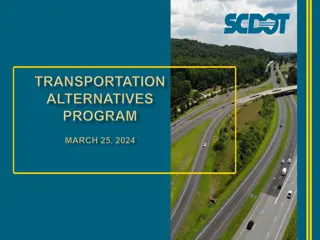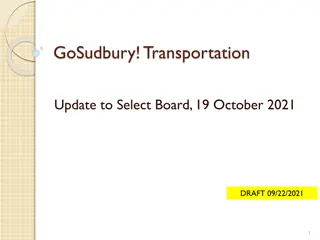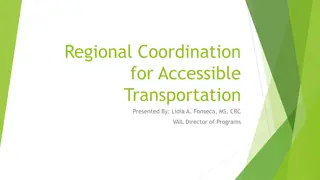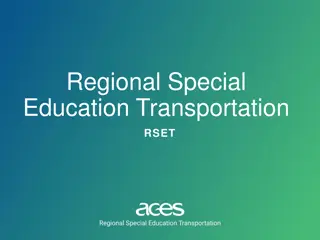Comprehensive Vision for Integrated Transportation System
A vision framework addressing the needs of bike, pedestrian, rail, and public transit across urban and rural areas, with an emphasis on safety, public health, connectivity, sustainability, and congestion relief. The framework aims to secure sufficient funding, promote active transportation, reduce roadway congestion, improve air quality, and create an integrated and seamless transportation system. Key concepts include safety outcomes, connectivity, sustainability, and revenue generation. Discussions focus on developing a subcommittee vision statement that encompasses all modes of transportation and regions, incorporating goals of congestion relief.
Download Presentation

Please find below an Image/Link to download the presentation.
The content on the website is provided AS IS for your information and personal use only. It may not be sold, licensed, or shared on other websites without obtaining consent from the author.If you encounter any issues during the download, it is possible that the publisher has removed the file from their server.
You are allowed to download the files provided on this website for personal or commercial use, subject to the condition that they are used lawfully. All files are the property of their respective owners.
The content on the website is provided AS IS for your information and personal use only. It may not be sold, licensed, or shared on other websites without obtaining consent from the author.
E N D
Presentation Transcript
Framework for an overall Vision Bike Passenger Rail Ped Transit A vision framework that speaks to need across modes
Framework for an overall Vision Rural bike, ped, public transportation needs Urban bike, ped, transit needs A vision framework that speaks to both urban and rural need
Notes from Previous Sub Meetings: What is the vision for a transportation system across all modes? (bike, ped, transit and passenger rail) funding sufficient to meet future need and growth related challenges sufficient and stable funding to meet current need Improve public health (in terms of transportation safety and physical activity) bike, ped, transit and rail options as a tool to reduce roadway congestion meet statewide goals for air quality and emissions reductions A connected and integrated transportation system (across jurisdictions) An integrated and seamless transportation system (between modes)
Key Concepts: 1. Safety and public health outcomes 2. Connectivity and integration (jurisdictional): 3. Connectivity and integration (modal): 4. Sustainability and emissions outcomes: 5. [Congestion relief outcomes:] 6. Revenue
Vision Discussion: 1. What is the overarching subcommittee vision that speaks across modes (bike, ped, transit) and across regions (urban, suburban, and rural)?* *Question: How do we incorporate goals of congestion relief into this vision? Subcommittee Deliverable: A draft subcommittee vision statement (expressed in 3-5 sentences)
Bike/Ped/Transit/Rail safety and public health outcomes: Concept Goals (long term) Strategy or Potential Recommendations (near term) 1. A drastic reduction in transportation related death and injury, particularly for vulnerable populations a) Roadway system designs that enhance safety for vulnerable users A transportation system that enhances public health though improved safety and increased physical activity (active transportation). b) Investment in bike/ped outside the existing ROW 2. A population with lower rates of obesity, heart disease, etc., stemming from an increase in active transportation c) Enhancement of Safe Routes to Schools programs d) Enhancement of Transportation Options programs that encourage active transportation e) Investment in first mile/last mile connections that improve safety
Bike/Ped/Transit/Rail: connectivity and integration (jurisdictional): Concept Goals (long term) Strategy or Potential Recommendations (near term) 1. Public transportation users can rely on a system that is integrated across multiple jurisdictions a) Address gaps in network of transit providers across state A connected and integrated transportation system across transportation providers, and jurisdictions b) Coordinate assets of rural/urban transit and transportation providers (fixed route transit, paratransit, senior, student, tribal transportation, etc.) 2. Transportation assets are optimized for greatest possible efficiency c) Improve efficiency, reliability and integration of transportation across jurisdictions and providers through innovative technology 3. Mobility hubs (such as the Salem Transit Depot) integrate transportation service across providers and jurisdictions d) Identify ways to reduce cost and improve efficiency of student transportation e) Develop Public Private Partnerships for paratransit and on-demand transit
Bike/Ped/Transit/Rail: connectivity and integration (modal): Concept Goals (long term) Strategy or Potential Recommendations (near term) A connected and integrated transportation system between transportation modes 1. Integration between modes is optimized through first mile/last mile connections a) Improve efficiency, reliability and integration of transportation across modes through innovative technology b) Prioritize investment in first mile/last mile connections that enhance efficacy and safety for transportation system users 2. Mobility hubs provide a link between modes and last mile connections c) Identify ways to reduce cost and improve efficiency of student transportation
Bike/Ped/Transit/Rail sustainability and emissions outcomes: Concept Goals (long term) Strategy or Potential Recommendations (near term) 1. A system that provides a measurable reduction in air pollution and carbon emissions a) Investment in transportation modes that reduce emissions A transportation system that supports Oregon s statewide sustainability and emissions reduction goals. b) Investment in transit and bike/ped system improvements that target congested roadway corridors 2. A system that limits future growth in VMT as a consequence of a growing population 3. Reduction in roadway demand and congestion through transit and bike/ped system improvements 4. Increase in mode share of [mode] to [x] percent
Congestion relief outcomes: Concept Goals (long term) Strategy or Potential Recommendations (near term) Reduce congestion on the transportation system through investments in transit, bike, ped, and passenger rail For discussion: what is the long term goal that this subcommittee sees? For discussion: What are the specific strategies that address the congestion concept?
Transit (near term revenue): Concept Near Term Goals Near Term Strategy or Potential Recommendations 1. Revenue that is sufficient to leverage federal funding Revenue that is sufficient to close critical system gaps across the state Operations revenue sufficient to meet current demand Revenue sufficient to meet the needs of the elderly and disabled a) Enhance revenue options for local governments and transit districts I. Employee payroll tax? II. Local funding tools for senior and disabled transit? III. Greater flexibility for use of revenue dedicated to yellow bus service b) Increase the state investment in public transportation I. Sufficient to leverage federal funds II. New or existing state revenue sources? A public transportation system that has stable and sufficient funding to meet current system needs. 2. 3. 4.
Transit (long term revenue): Concept Long Term Goals Long Term Strategy or Potential Recommendations 1. A system that meets future demand from a growing and aging population a) Capital investment in, and expansion of, the public transportation system to meet a growing population b) Address constitutional restrictions associated with future transportation finance strategies (e.g., VMT tax, tolling, carbon tax, etc.) c) New revenue sources sufficient to cover operating costs of an expanded system: I. Expand local options for public transit? II. Employee payroll tax? III. Sin taxes (e.g., cigarette, cannabis, alcohol. Etc.) IV. Other new sources of transportation revenue? A public transportation system that has stable and sufficient funding to meet future mobility and growth-related challenges 2. A system that limits future growth in VMT as a consequence of a growing population
Bike/Ped (revenue): Concept Goals Strategy or Potential Recommendations 1. Off-system improvements or connectivity where appropriate Near Term: a) Revenue to address gaps and critical connections in existing system b) Investments in enhancements inside existing ROW c) Prioritize investment in user safety A bike and pedestrian transportation system that has stable and sufficient funding to meet current system needs and future mobility and growth-related challenges 2. Revenue sufficient to create a safe network for those who bike and walk, targeting zero deaths Long Term: a) Address constitutional restrictions associated with future transportation finance strategies (e.g., VMT tax, tolling, carbon tax, etc.) to provide greater flexibility for off-system improvements
Passenger Rail (revenue): Concept Goals (long term) Strategy or Potential Recommendations (near term) From Outline: 1. Improve intercity passenger rail service, high-speed rail improvements that provide a backbone of fast, efficient, frequent, and reliable service between Eugene, Oregon and Vancouver, British Columbia. 2. Increase job access, link communities and major educational institutions, and connect potential customers to goods and services. a) Identify a sustainable revenue source for Passenger Rail service that meets current need, and lays the groundwork for future rail enhancements Revenue needed to maintain current service Revenue needed to improve the existing corridor to higher speed service b) Recommend Alternative 1?
Strategy/Recommendations Discussion: Do these concepts capture the breadth of subcommittee findings? Are there more specific strategies or recommendations that can be teased out of these concepts? What should be the top-priority recommendations?


